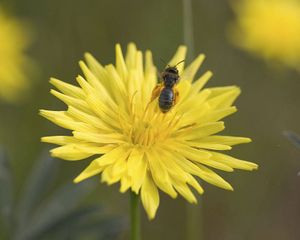Difference between revisions of "Microseris laciniata subsp. laciniata"
m (Haysar24 moved page Microseris laciniata to Microseris laciniata subsp. laciniata without leaving a redirect: subspecies clarification) |
m (→Uses) (Tag: VisualEditor) |
||
| Line 35: | Line 35: | ||
==Bloom Period== | ==Bloom Period== | ||
| − | May-July<ref>Bowcutt, F., & Hamman, Sarah. (2016). ''Vascular plants | + | May-July<ref>Bowcutt, F., & Hamman, Sarah. (2016). ''Vascular plants'' |
| − | of the South Sound prairies'' (First ed.). Olympia, Washington: The Evergreen | + | of the South Sound prairies'' (First ed.). Olympia, Washington: The Evergreen'' |
State College Press.</ref> | State College Press.</ref> | ||
| Line 46: | Line 46: | ||
==Uses== | ==Uses== | ||
| + | Documentation of Pomo use of roots for food.<ref>Native American Ethnobotany Database. Retrieved from <nowiki>http://naeb.brit.org/uses/search/?string=Microseris+laciniata</nowiki></ref> | ||
===Seed=== | ===Seed=== | ||
| Line 76: | Line 77: | ||
== References == | == References == | ||
| + | <references /> | ||
Revision as of 20:47, 4 June 2020
- Latin Name: Microseris laciniata subsp. laciniata
- Family: Asteraceae
- Common Names: cut-leaved microseris,
- Synonyms/misapplications: Microseris procera
- Codon: MICLAC
Contents
Taxonomy
| Microseris laciniata | |
|---|---|

| |
| Photo by Rod Gilbert, also featured on Main Page | |
| Scientific classification | |
| Kingdom: | Plantae |
| Subkingdom: | Tracheobionta |
| Phylum: | Spermatophyta |
| Subphylum: | Magnoliophyta |
| Class: | Magnoliopsida |
| Subclass: | Asteranae |
| Order: | Asterales |
| Family: | Asteraceae |
| Genus: | Microseris D. Don |
| Species: | Microseris laciniata (Hook.) Sch. Bip. |
| Subspecies: | Microseris laciniata subsp. laciniata (Hook.) Sch. Bip. |
Description
Taprooted perennial, variable habit, 1.5-12 dm tall.
Leaves mostly basal, from entire to deeply pinnatifid.
Heads ligulate, solitary, long-pedunculate. Flowers yellow. Phyllaries unequal, 3-5 seriate. Pappus scales 5-10, white to yellowish.
Achene 5-6 mm, beakless.[1][2]
Bloom Period
May-July[3]
Distribution
Southern Puget Trough southward, on both sides of Cascades to California.[1]
Habitat
Clay, loam, and rocky soils, grasslands, moist meadows, dried slopes, woodlands.[1]
Uses
Documentation of Pomo use of roots for food.[4]
Seed
Seed sample from: 2011
Average Measurement: 5.6 x 0.8 x 0.8
Measurement Range: L: 4.75 – 7, W: 0.5 – 0.9, D: 0.5 – 0.9
Features
Shape: Seed tubular with puckered hilum.
Additional Structures: Pappus attached at apex opposite hilum. Pappus fibers are attached in a circular pattern around end. Individual hairs are broad at point of attachment, narrowing to a point. Pappus fibers exceptionally broad, somewhat iridescent, and 1/10 – 1/3 as long as seed body.
Color: Hilum white, seed body tan or light brown.
Surface: Seed body has 10 – 15 grooves running longitudinally from hilum to pappus. Hilum is glossy but seed body is smooth and matte
Latitudinal Cross Section: elliptical 
Longitudinal Cross Section: elliptical ![]()
Photo Gallery
References
- ↑ 1.0 1.1 1.2 Hitchcock, C. L., Cronquist, A., Giblin, D., & Legler, B. et al. (2018). Flora of the Pacific Northwest: an illustrated manual. Seattle: University of Washington Press.
- ↑ WTU Herbarium, Burke Museum, & University of Washington. Retrieved from https://biology.burke.washington.edu/herbarium/imagecollection/taxon.php?Taxon=Microseris%20laciniata
- ↑ Bowcutt, F., & Hamman, Sarah. (2016). Vascular plants of the South Sound prairies (First ed.). Olympia, Washington: The Evergreen State College Press.
- ↑ Native American Ethnobotany Database. Retrieved from http://naeb.brit.org/uses/search/?string=Microseris+laciniata



